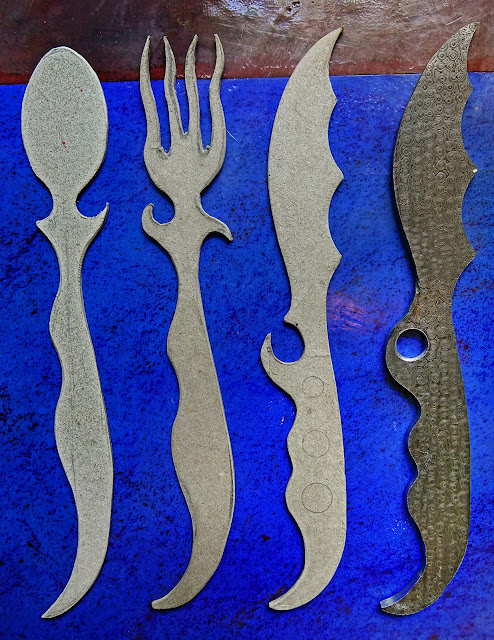I started drawing what I thought was going to be a whole series of design variations, but ended up liking my very first draft so much that I went ahead with it. First, I cut out a test knife out of a bar of ordinary Home Depot steel for practice. I hammered the narrow blade, which gave it a curve, and that made me decide on the grinding route instead of trying to forge. It's a lot easier, and I already have pretty much all the tools. I used paste Gun Blue to turn the handle black:
Then, I drew the knife, spoon and fork full size, and made some cardboard mockup. I wonder about making them out of ordinary steel for practice, but then decided to cut out a blank for the knife directly out of the bar of Damascus Steel I had just received:
Then, I drew the knife, spoon and fork full size, and made some cardboard mockup. I wonder about making them out of ordinary steel for practice, but then decided to cut out a blank for the knife directly out of the bar of Damascus Steel I had just received:
The steel was actually much softer than I was expecting, about the same as the cheap one. I used my counter rotating tungsten blade tool to rough out the shape, a disk grinder to refine the convex shapes, and my small belt grinder to shape the concave curves. The diameter of the upper pulley is exactly what I needed. I also used an air grinder with a straight tungsten bit. I am debating about drilling a set of 3 graduated holes down the handle... I am also debating whether to leave the shapes square, or to round the whole thing, which would have the advantage of making the pieces lighter, but would take a whole lot more time. I may have do do a test piece each way and show them to Rachel.
Also, trying to decide what kind of profile to use on the blade: V, shallow V, hollow ground, or convex (the easiest, and sturdiest, least likely to crack on tempering, and sufficiently sharp for a table knife):







No comments:
Post a Comment